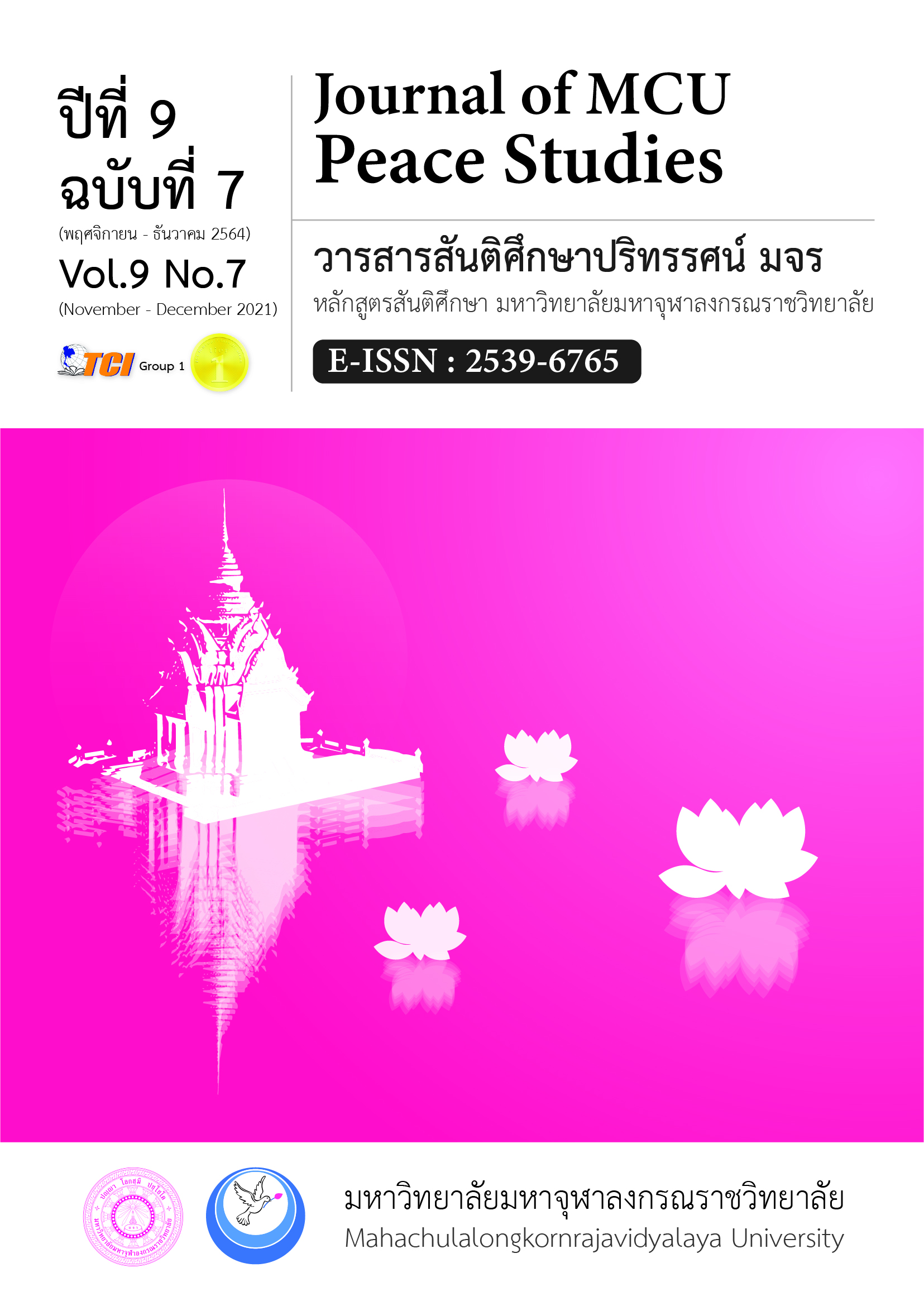รูปแบบการสื่อสารเพื่อลดความเสี่ยงในการปฏิบัติงานของอาสาสมัครสาธารณสุข ในสถานการณ์การแพร่ระบาดของเชื้อไวรัสโควิด 19 ในพื้นที่จังหวัดยะลา
Main Article Content
บทคัดย่อ
บทความวิจัยนี้มีวัตถุประสงค์เพื่อศึกษา 1) กระบวนการสื่อสาร และ 2) พฤติกรรมการปฏิบัติงาน 3) ปัจจัยการสื่อสารที่ส่งผลต่อพฤติกรรม และ4) รูปแบบการสื่อสารเพื่อลดความเสี่ยงในการปฏิบัติงานของอาสาสมัครสาธารณสุขในสถานการณ์การแพร่ระบาดของเชื้อไวรัสโควิด 19 ในพื้นที่จังหวัดยะลา เป็นการวิจัยแบบผสม ทั้งเชิงคุณภาพและเชิงปริมาณ ผู้ให้ข้อมูลหลัก คือ ผู้แทนหน่วยงาน/องค์กรที่มีบทบาทในการส่งเสริม สนับสนุนการป้องกันการแพร่ระบาดของเชื้อไวรัสโควิด 19 และผู้แทนอาสาสมัครสาธารณสุขประจำหมู่บ้าน จำนวน 12 คน ใช้วิธีการเลือกแบบเจาะจง เครื่องมือที่ใช้ในการวิจัยคือ แบบสัมภาษณ์กึ่งโครงสร้าง แบบประเมินผล โดยวิธีการสัมภาษณ์เชิงลึก วิธีการประเมินผล วิเคราะห์ข้อมูลโดยการวิเคราะห์เชิงพรรณนา และการวิเคราะห์ข้อมูลค่าฐานนิยม 2 ใน 3 ของความเห็นผู้ทรงคุณวุฒิ ผู้เชี่ยวชาญ กลุ่มตัวอย่างในการวิจัยเชิงปริมาณ คือ อาสาสมัครสาธารณสุขประจำหมู่บ้านในพื้นที่ที่มีรายงานการติดเชื้อโควิด 19 โดยการสุ่มอย่างง่าย จำนวน 361 คน เครื่องมือที่ใช้ในการเก็บรวบรวมข้อมูลคือ แบบสอบถาม ใช้การวิเคราะห์ความถดถอยพหุคูณ และวิเคราะห์ข้อมูลโดยใช้สถิติค่าความถี่ ค่าร้อยละ ค่าเฉลี่ย ค่าส่วนเบี่ยงเบนมาตรฐาน ผลการวิจัยพบว่า 1) กระบวนการสื่อสารที่สำคัญ คือ กระบวนการสื่อสารในระดับนโยบาย ระดับเครือข่ายการทำงาน และระดับปฏิบัติการ 2) พฤติกรรมการปฏิบัติงานที่สำคัญ คือ พฤติกรรมการปฏิบัติตัวตามมาตรการของกระทรวงสาธารณสุข 3) ปัจจัยการสื่อสารที่ส่งผลต่อพฤติกรรมที่สำคัญ คือ มาตรการของภาครัฐ และเพศของผู้ที่รับข้อมูลข่าวสาร และ 4) รูปแบบการสื่อสารเพื่อลดความเสี่ยงในการปฏิบัติงาน คือ รูปแบบการสื่อสารที่อาสาสมัครสาธารณสุขประจำหมู่บ้านเป็นทั้งผู้ส่งสารและผู้รับสาร
Article Details

อนุญาตภายใต้เงื่อนไข Creative Commons Attribution-NonCommercial-NoDerivatives 4.0 International License.
ทัศนะและความคิดเห็นที่ปรากฏในบทความในวารสาร ถือเป็นความรับผิดชอบของผู้เขียนบทความนั้น และไม่ถือเป็นทัศนะและความรับผิดชอบของกองบรรณาธิการ ยินยอมว่าบทความเป็นลิขสิทธิ์ของวารสาร
เอกสารอ้างอิง
Committee of Thai Language for Communication of the Integration Center for General Education (2007). Thai Language for Communication. (2nd ed.). Bangkok: Kasetsart University.
Dahnke, G. L., & Clatterbuck, G. W. (1990). Human Communication: Theory and Research. Belmont, CA: Wadsworth Publishing Co.
Department of Disease Control. (2020). Information for Self-Protection Against the Novel Coronavirus 2019. Bangkok: Ministry of Public Health.
_______. (2020). Provincial reported infection of COVID-19. Retrieved July 29, 2020, from https://covid19.ddc.moph.go.th/
Department of Health Service Support. (2019). Handbook of Village Health Volunteers for Home Doctoring. Bangkok: Ministry of Public Health.
_______. (2 0 1 9 ). Manual for village health volunteers as a home doctoring. Bangkok: Ministry of Public Health.
Development of Human Resource and Compensation (2020). Publication on Measures for Self-Protection at the Time of Covid-19. Samutsongkram: Administration Department of the Municipal Clerk Office Samutsongkram Municipality.
Hovland, C. I., Janis, I. L., & Kelly, H. H. (1953). Communication and persuasion. New Haven: Yale Press.
Kluger, D. M. et al. (2020). Impact of Healthcare Worker Shift Scheduling on Workforce Preservation during the COVID-1 9 Pandemic. Infection Control & Hospital Epidemiology, 41(12), 1443 – 1445.
Lui, L., & Standing, L. G. (1989). Communication credibility: Trustworthiness defeats expertness. Social Behavior and Personality, 17(2), 219-221.
Meetongpan, T. (1997). Behavioral Science. Bangkok: Bansomdejchaopraya Rajabhat University.
Nitikasetsoontorn, P. (2005). Key concepts of communication. In The teaching material of the Communication Arts and Theories. Nonthaburi: Sukhothai Thammathirat Open University School of Communication Arts.
Nitikasetsoontorn, P. (2003). Introduction to communication and communication behavior. In The teaching material of the Theories and Behaviors of Communication. Nonthaburi: Sukhothai Thammathirat Open University School of Communication Arts.
Office of the Primary Health Care Committee. (1997). Primary Health Care in Thailand. Bangkok: Printing Press of the War Veterans Organization of Thailand.
Posner, B. Z., & Kouzes, J. M. (1988). Relating leadership and credibility. Psychological Reports, 63(2), 527-530.
Prakobpol, R. (2001). Components and processes of communication. In The teaching material of Communication Principles and Theories. Nonthaburi: Sukhothai Thammathirat Open University School of Communication Arts.
Srichai, C. (2 0 1 4 ). Communications for social harmony in the three southern border provinces. ( Doctoral Dissertation) . Sukhothai Thammathirat Open University. Nonthaburi.
Trisakul, S. (2007). Principles of communication. Faculty of Management Science, Suan Sunandha Rajabhat University. Bangkok: Pattana online.
Wagner, E.H. et al. (2001). Improving chronic illness care: Translating evidence into action. Health Aff (Millwood), 20(6), 64-78.
World Health Organization. (2004). Outbreak communication. Geneva: WHO Press.
_______. (2009). Why health communication is important in public Health. Retrieved July 15, 2020, from https://www.who.int/bulletin/volumes/87/4/08-056713/en/
_______. (2012). Communication for behavioural impact. Geneva: WHO Press.
_______. (2017). Communicating risk in public health emergencies. Geneva: WHO Press.
Yenjabok, P. (2004). Knowledge and Media Literacy Development: Concepts, Principles and Case Studies for Media Literacy in Health. Bangkok: Developmental Project in Communication for Health of Kasetsart University Research and Development Cente.


